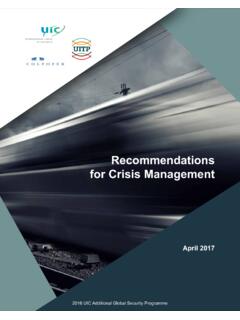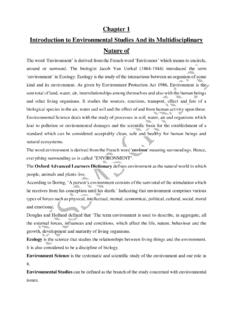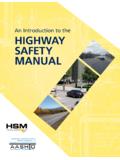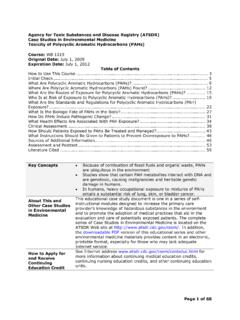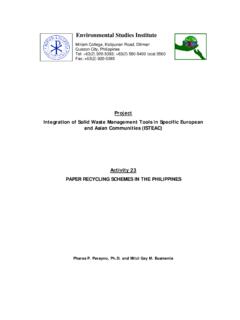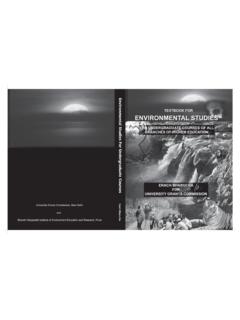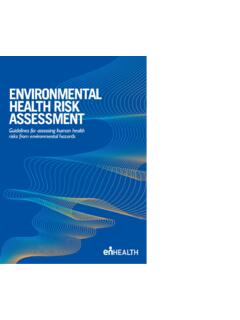Transcription of Environmental Impact of railway infrastructure
1 Matthias Tuchschmid Carbon Footprint and Environmental Impact of railway In- frastructure Heidelberg Z rich Berlin Matthias Tuchschmid Fellenbergweg 14. commissioned by CH-8057 Z rich International Union of railways (UIC IFEU-Institut Wilckensstra e 3. D-69120 Heidelberg Tel.+49 (0) 6221-4767-0. Fax+49 (0) 6221-4767-19. Authors: Matthias Tuchschmid Wolfram Kn rr (IFEU) ko-Institut B ro Berlin Alexander Schacht (IFEU) Schicklerstr. 5-7. D-10179 Berlin Moritz Mottschall ( ko-Institut) Tel. +49 (0) 30 40 50 85-380. Fax +49 (0) 30 40 50 85-388. Martin Schmied ( ko-Institut) ko-Institut Matthias Tuchschmid IFEU Heidelberg Content: List of figures .. V. List of tables .. VI. List of abbreviations .. VIII. 1 Introduction .. 1. Goals & Scope .. 1. Structure of 2. 2 Literature review .. 3. 3 Methodology for assessment of rail infrastructure .. 5. 5. Primary energy .. 5. CO2 as an indicator of greenhouse gas potential .. 6. Particulate matter: PM10 und .. 6.)
2 Non-methane volatile organic compounds: NMVOC .. 6. Nitrogen oxides: NOx .. 7. Modeling principles .. 8. Modeling 8. System Boundaries .. 8. Lifespan of considered elements .. 9. Modelling the Impact of rail 10. Modelling the Impact of rolling stock .. 13. Modelling the Impact of train operation .. 14. Modelling transport services .. 15. Transport on different networks, local 15. Considerations .. 15. Data sources & Impact factors .. 17. 4 Assessing the rail 18. Construction and maintenance of tracks .. 18. Earthwork .. 19. Bridges: viaduct, concrete bridge over a road and iron bridge .. 20. Tunnel: mining and open-pit procedure .. 21. Sleeper & Ballast: concrete, wood, iron and closed 23. II Carbon footprint of railway infrastructure IFEU Heidelberg Matthias Tuchschmid ko-Institut Rail: UIC 60, S54 and S49 .. 24. Mast, catenaries and overhead 25. Signalisation & communication .. 26. Construction and maintenance of relevant buildings .. 27. Construction and maintenance of trains.
3 28. Train operation and energy provision for 29. 5 Relevance of rail infrastructure in several European countries .. 30. Embedded Calculator / Online-Calculator .. 30. Country specific networks .. 31. 31. Switzerland .. 34. France .. 36. Italy .. 37. Spain .. 38. Norway .. 39. Belgium .. 40. 41. 42. Overview and 43. Carbon Footprint of rail infrastructure per km of line.. 43. Carbon Footprint of rail infrastructure per pkm .. 43. Carbon footprint of rolling stock .. 44. Carbon footprint of Operation .. 44. 6 Summary & Recommendations .. 45. Share of rail 45. UIC-Tools EcoPassenger & EcoTransIT and the infrastructure .. 47. 7 Literature & References .. 49. Literature .. 49. Picture Credits .. 51. Literature Review .. 53. Overview .. 53. Description of sources .. 55. III. ko-Institut Matthias Tuchschmid IFEU Heidelberg 8 Annex .. 77. Further Data sources .. 77. Questionnaire .. 78. IV Carbon footprint of railway infrastructure IFEU Heidelberg Matthias Tuchschmid ko-Institut List of figures Figure Scheme of relevant processes for rail 2.
4 Figure Impact calculation of the rail infrastructure .. 12. Figure Impact calculation of the rolling stock .. 13. Figure : Impact calculation of the operation .. 14. Figure : Scheme of rail track .. 18. Figure : Earthwork as precondition for the track construction .. 19. Figure : Assessed types of rail bridges: viaducts, smaller bridges and iron bridges .. 20. Figure : Assessed types of tunnels: mining and open pit 21. Figure : Assessed types of sleepers: concrete sleepers, wooden sleepers, iron sleepers and closed lane .. 23. Figure : Assessed types of rails: UIC60, S54 and S49 .. 24. Figure : Assessed types of overhead system: Mast, Catenary and overhead wiring .. 25. Figure : Assessed types of signalization and communication .. 26. Figure : Assessed types of buildings: concrete sleepers, wooden sleepers, iron sleepers and closed lane .. 27. Figure : Assessed types of trains: Regional trains, intercity trains and freight trains .. 28. Figure : Assessed types of energy: electricity, Natural Gas and oil.
5 29. Figure 30. Figure : Online Calculator for the determination of the Environmental Impact of railway infrastructure .. 31. Figure : Carbon Footprint per km of line and year .. 43. Figure : Carbon Footprint per passenger kilometre .. 44. Figure : Carbon Footprint of the train operation in selected 44. Figure : Carbon Footprint of rail transport in selected 45. Figure : Overview of the Questionnaire .. 78. Figure : Questionnaire for the determination of bridges & tunnels .. 79. V. ko-Institut Matthias Tuchschmid IFEU Heidelberg List of tables Table : Overview of selected studies dealing with carbon footprint of railway infrastructure and other 4. Table : Considered lifespan of the assessed elements .. 10. Table : Selected emission factors from Ecoinvent .. 17. Table : Impact from the earthwork per km and year .. 19. Table : Impact of bridges per km and year .. 20. Table : Impact of tunnels per km and year .. 21. Table : Sensitivity analysis of steel production with other electricity mixes.
6 22. Table : Impact of sleeper and ballast per km and year .. 23. Table : Impact of rail per km and year .. 24. Table : Impact of mast, catenary and overhead wiring per km and 25. Table : Impact of Signals and communication per km and year .. 26. Table : Impact from the construction and maintenance of railway buildings, per unit and year .. 27. Table : Impact from the construction and maintenance of trains, per unit and year .. 28. Table : Impact from the construction and maintenance of trains, per Gtkm passenger train .. 28. Table : Impact from the energy provision per kWh used 29. Table : Data for Germany .. 32. Table : Carbon Footprint of Rail in Germany .. 32. Table : Bottom up vs. Top-down: Example of a rail network .. 33. Table : Data for Switzerland .. 34. Table Carbon Footprint of Rail in Switzerland .. 34. Table : Carbon footprint of rail in Switzerland with a lifespan of building and civil engineering constructions of 100 years instead of 60 years.
7 35. Table : Data for France .. 36. Table : Carbon Footprint of Rail in France .. 36. Table : Data for Italy .. 37. Table : Carbon Footprint of Rail in Italy .. 37. Table : Data for Spain .. 38. Table : Carbon Footprint of Rail in Spain .. 38. Table : Data for Norway .. 39. Table : Carbon Footprint of Rail in Norway .. 39. Table : Data for Norway .. 40. Table : Carbon Footprint of Rail in Norway .. 40. VI Carbon footprint of railway infrastructure IFEU Heidelberg Matthias Tuchschmid ko-Institut Table : Data for Japan .. 41. Table : Carbon Footprint of Rail in Japan .. 41. Table : Data for India .. 42. Table : Carbon Footprint of Rail in India .. 42. VII. ko-Institut Matthias Tuchschmid IFEU Heidelberg List of abbreviations Abbr. Explanation CH4 methane CO carbon monoxide CO2 carbon dioxide EU European Union EPD Environmental Product Declarations g gram GHG greenhouse gas GWP Global Warming Potential HDPE High Density Polyethylen HSR high-speed rail ICE Inter City Express IPCC International Panel on Climate Change ISO International Organization for Standardization Kg kilogram km/h kilometre per hour kWh kilowatt-hour N2O nitrous oxide (laughing gas or sweet air).
8 NMVOC non-methane volatile organic compounds NOx nitrogen oxide pkm passenger-kilometres PCR Product Category Rules PM10 particulate matter PVC Polyvinylchlorid SF6 sulphur hexafluoride SO2 sulphur dioxide TGV Train Grande Vitesse tkm tonne-kilometres UIC Union Internationale des Chemins de fer VIII Carbon footprint of railway infrastructure IFEU Heidelberg Matthias Tuchschmid ko-Institut 1 Introduction Comprehensive tools for the comparison of the Environmental Impact of different trans- port modes have been developed. The International Union of railways UIC has worked out two tools: EcoTransIT for freight- and EcoPassenger for passenger transport. Both on-line calculators focus on the operation of vehicles and take the upstream emis- sions from energy supply into account. infrastructure such as track system or the pro- duction of vehicles (see Figure ) is excluded. Especially within large rail projects, policy makers and the public wondered if the share of track and vehicles construction is significant.
9 Relevant issues are: What is the carbon footprint of the construction of viaducts and tunnels? What is the Environmental Impact of transport network density, rail utilization num- bers, and composition of the electricity mix in proportion to the carbon footprint of the infrastructure ? Does the inclusion of infrastructure (tracks, vehicles) significantly change the rela- tion of greenhouse gas emissions between road and rail? Goals & Scope The purpose of the study is: to develop a methodology and a calculation tool in order to determine the carbon footprint and the Environmental Impact for railway infrastructure , based on a comprehensible and easily applicable methodology, to identify and collect data needed to determine the carbon footprint of railway infrastructure of different European countries, to determine the carbon footprint of infrastructure for selected countries compared to the total Impact of railway transport (operation and infrastructure ).
10 1. ko-Institut Matthias Tuchschmid IFEU Heidelberg Figure Scheme of relevant processes for rail transport Cumulative energy demand (included inf rastructure). Primary energy consumption (without inf rastructure) Construction, Construction, maintenance, maintenance, operation and operation and disposal of disposal of Energy consumption f or the energy provision Final energy railway tracks vehicles consumption on board of the train Energy production Energy distribution Construction incl. Extraction f rom Ref ineries &. ground deposits Operation Inf rastructure Vehicles deposal power stations Construction incl. Generation of deposal renewable energy Transport The elements on the left side (green color) are covered by the existing tools of eco- TransIT / EcoPassenger, the elements on right side (construction, maintenance and disposal of railway tracks and rolling stock) are within the focus of this study. Source: UIC (2010). Structure of report An overview of the existing studies concerning the infrastructure of transport can be found in the next chapter of this study.



